 W
WFunerary art is any work of art forming, or placed in, a repository for the remains of the dead. The term encompasses a wide variety of forms, including cenotaphs, tomb-like monuments which do not contain human remains, and communal memorials to the dead, such as war memorials, which may or may not contain remains, and a range of prehistoric megalithic constructs. Funerary art may serve many cultural functions. It can play a role in burial rites, serve as an article for use by the dead in the afterlife, and celebrate the life and accomplishments of the dead, whether as part of kinship-centred practices of ancestor veneration or as a publicly directed dynastic display. It can also function as a reminder of the mortality of humankind, as an expression of cultural values and roles, and help to propitiate the spirits of the dead, maintaining their benevolence and preventing their unwelcome intrusion into the lives of the living.
 W
WAngel of Grief or the Weeping Angel is an 1894 sculpture by William Wetmore Story for the grave of his wife Emelyn Story at the Protestant Cemetery in Rome. Its full title bestowed by the creator was The Angel of Grief Weeping Over the Dismantled Altar of Life.
 W
WThe Cadaver Tomb of René of Chalon is a late Gothic period funerary monument, known as a transi, in the church of Saint-Étienne at Bar-le-Duc, in northeastern France. It consists of an altarpiece and a limestone statue of a putrefied and skinless corpse which stands upright and extends his left hand outwards. Completed sometime between 1544 and 1557, the majority of its construction is attributed to the French sculptor Ligier Richier. Other elements, including the coat of arms and funeral drapery, were added in the 16th and 18th centuries respectively.
 W
WRobert Cauer the Elder was a German sculptor; known for his funerary art.
 W
WThe Chapel of San Bartolomé is a funerary chapel in the historic centre of Córdoba, Spain. It is dated between 1390 and 1410. Richly decorated, it is one of the city's finest examples of Mudéjar art.
 W
WThe Cloisters, also known as the Met Cloisters, is a museum in Fort Tryon Park in Washington Heights, Manhattan, New York City, specializing in European medieval art and architecture, with a focus on the Romanesque and Gothic periods. Governed by the Metropolitan Museum of Art, it contains a large collection of medieval artworks shown in the architectural settings of French monasteries and abbeys. Its buildings are centered around four cloisters—the Cuxa, Saint-Guilhem, Bonnefont and Trie—that were acquired by American sculptor and art dealer George Grey Barnard in France before 1913, and moved to New York. Barnard's collection was bought for the museum by financier and philanthropist John D. Rockefeller, Jr. Other major sources of objects were the collections of J. P. Morgan and Joseph Brummer.
 W
WDeath and the Sculptor, also known as the Milmore Monument and The Angel of Death and the Young Sculptor is a sculpture in bronze, and one of the most important and influential works of art created by sculptor Daniel Chester French. The work was commissioned to mark the grave in Forest Hills Cemetery in Jamaica Plain, Boston, Massachusetts, of the brothers Joseph (1841–1886), James and Martin Milmore (1844–1883). It has two figures effectively in the round, linked to a background relief behind them. The right-hand figure represents a sculptor, whose hand holding a chisel is gently restrained by the fingers of the left-hand figure, representing Death, here shown as a winged female.
 W
WJ. W. Fiske & Company of New York City was the most prominent American manufacturer of decorative cast iron and cast zinc in the second half of the nineteenth century. In addition to their wide range of garden fountains, statues, urns, and cast-iron garden furniture, they provided many of the cast-zinc Civil War memorials of small towns throughout the northern states following the American Civil War. These were commonly painted to imitate bronze.
 W
WFunerary art in Puritan New England encompasses graveyard headstones carved between c. 1640 and the late 18th century by the Puritans, founders of the first American colonies, and their descendants. Early New England puritan funerary art conveys a practical attitude towards 17th-century mortality; death was an ever-present reality of life, and their funerary traditions and grave art provide a unique insight into their views on death. The minimalist artistry of the early headstone designs reflect a religious doctrine, which largely avoided unnecessary decoration or embellishment.
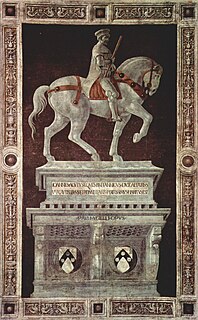 W
WThe Funerary Monument to Sir John Hawkwood is a fresco by Paolo Uccello, commemorating English condottiero John Hawkwood, commissioned in 1436 for Florence Cathedral. The fresco is an important example of art commemorating a soldier-for-hire who fought in the Italian peninsula and is a seminal work in the development of perspective.
 W
WGlebe Burying Ground, also known as Glebe Cemetery, is a historic cemetery located near Swoope, Augusta County, Virginia. It is one of the oldest cemeteries in Augusta County and contains a wide variety of stones illustrating the evolution of local funerary art from the 1770s through the 19th century. The surviving stones date from 1770 to 1891. They reflect changes in the local funerary art of Scotch-Irish, English, and German settlers and their descendants.
 W
WGold glass or gold sandwich glass is a luxury form of glass where a decorative design in gold leaf is fused between two layers of glass. First found in Hellenistic Greece, it is especially characteristic of the Roman glass of the Late Empire in the 3rd and 4th century AD, where the gold decorated roundels of cups and other vessels were often cut out of the piece they had originally decorated and cemented to the walls of the catacombs of Rome as grave markers for the small recesses where bodies were buried. About 500 pieces of gold glass used in this way have been recovered. Complete vessels are far rarer. Many show religious imagery from Christianity, traditional Greco-Roman religion and its various cultic developments, and in a few examples Judaism. Others show portraits of their owners, and the finest are "among the most vivid portraits to survive from Early Christian times. They stare out at us with an extraordinary stern and melancholy intensity". From the 1st century AD the technique was also used for the gold colour in mosaics.
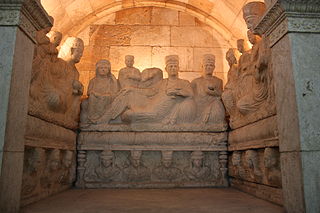 W
WThe Hypogeum of Yarhai is a hypogeum from the ancient Syrian city of Palmyra which flourished in the second and third centuries AD. It is considered one of the finest examples of Palmyrene funerary art. It's a mass grave which was built to contain the remains of the Yarhai family who commissioned it to be built in 108 AD.
 W
WAn immortelle is a long-lasting flower arrangement placed on graves in cemeteries.
 W
WThe Layer monument is an early 17th-century polychrome marble mural monument erected in the memory of the lawyer Christopher Layer (1531–1600), and located in the Church of Saint John the Baptist, Norwich.
 W
WThe Layer Quaternity are four marble sculpture figurines approximately 25 centimetres (10 in) in height located on the two columns of the Layer Monument, an early 17th-century polychrome mural monument which was installed in the Church of Saint John the Baptist, Maddermarket, Norwich to the memory of Christopher Layer (1531–1600).
 W
WFunerary reliefs of married couples were common in Roman funerary art. They are one of the most common funerary portraits found on surviving freedmen reliefs. By the fourth century, a portrait of a couple on a sarcophagus from the empire did not necessarily signify the burial of two spouses but instead demonstrated the importance of the material bond.
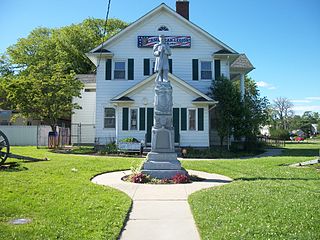 W
WThe Monumental Bronze Company of Bridgeport, Connecticut was a monumental mason firm specializing in the production of white bronze (zinc) monumental masonry, active between 1875 and 1912 with subsidiaries throughout the United States, and Canada.
 W
WThe Moreel Triptych is the name given to a 1484 panel painting by the Early Netherlandish painter Hans Memling. It was commissioned by the prominent Bruges politician, merchant and banker Willem Moreel and his wife Barbara van Vlaenderberch, née van Hertsvelde. It was intended as their epitaph at the chapel of the St. James's Church, Bruges, an extension they paid for, to the funerary church of Willem's family, where the couple intended to be interred in an underground tomb before the altar.
 W
WThe Mourners of Dijon are tomb sculptures made in Burgundy during the late fourteenth and early fifteenth centuries. They are part of a new iconographical tradition led by Claus Sluter that continued until the end of the fifteenth century. In this tradition, free-standing sculptures depict mourners who stand next to a bier or platform that holds a body in state. The figures are cloaked in robes which mostly hide their faces.
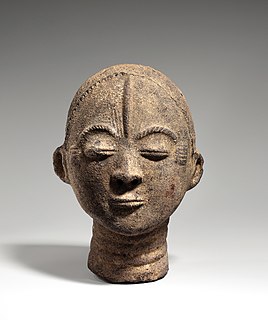 W
WThe Memorial Head or Nsodie is a type of 17th to 18th century ceramic portrait sculpture of the Akan peoples, believed to have been created by women artists depicting royal personages. They are represented in the collection of the Metropolitan Museum of Art and elsewhere.
 W
WPalmyrene funerary relief busts were first produced in Palmyra in the middle of the first century BC a decorative slabs closing the burial niches inside underground tombs. The reliefs were carved into square pieces of limestone and depicted figures in a direct frontal pose cut off at mid-torso. Arms and hands were portrayed in various gestures and poses. Most busts display a solitary figure, however some sculptures incorporate multiple figures of family members. Names and lineage of the deceased are engraved in Aramaic above the shoulders, and in some cases, with Greek or Syriac.
 W
WPleurants or weepers are anonymous sculpted figures representing mourners, used to decorate elaborate tomb monuments, mostly in the late Middle Ages in Western Europe. Typically they are relatively small, and a group were placed around the sides of a raised tomb monument, perhaps interspersed with armorial decoration, or carrying shields with this. They may be in relief or free-standing. In English usage the term "weepers" is sometimes extended to cover the small figures of the deceased's children often seen kneeling underneath the tomb effigy in Tudor tomb monuments.
 W
WThe Rucellai Sepulchre is a small funerary chapel built inside the Rucellai Chapel of the church of San Pancrazio, Florence. It was commissioned by Giovanni di Paolo Rucellai and built to designs by Leon Battista Alberti in imitation or emulation of the Holy Sepulchre in the Anastasis in Jerusalem. It contains the tombs of Giovanni Rucellai and members of his family.
 W
WSharon Lutheran Church and Cemetery is a historic Lutheran church and cemetery located near Ceres, Bland County, Virginia. The church was built in 1883, and is a one-story, frame church, four bays long, with round-arched, stained-glass windows and a gable roof. It features a projecting square tower with a bell-cast pyramidal roof and cross finial on the entrance facade. The adjacent cemetery was established in 1817, and includes a collection of rare Germanic gravestones which are stylistically related to those found in the outlying churches of the Wythe County German settlements.
 W
WThe Statue of Horemheb and Amenia is a large double statue of the Pharaoh Horemheb and his wife Amenia that was found at the ancient site of Saqqara in Egypt. Now kept at the British Museum, for many years the identity of the two sitters was unknown until a team of Dutch and British archaeologists discovered a missing fragment of the statue in Horemheb's tomb in Saqqara.
 W
WSubmycenaean pottery is a style of ancient Greek pottery. It is transitional between the preceding Mycenaean pottery and the subsequent styles of Greek vase painting, especially the Protogeometric style. The vases date to between 1030 and 1000 BC.
 W
WTang dynasty tomb figures are pottery figures of people and animals made in the Tang dynasty of China (618–906) as grave goods to be placed in tombs. There was a belief that the figures represented would become available for the service of the deceased in the afterlife. The figures are made of moulded earthenware with colour generally being added, though often not over the whole figure, or in naturalistic places. Where the colouring was in paint it has often not survived, but in many cases it was in sancai ("three-colour") ceramic glaze, which has generally lasted well.
 W
WStanding Horse is a tomb figure created during the Tang dynasty in China. In ancient China, numerous tomb figurines and other artefacts were designed specifically to be buried with the deceased in large burial mounds. This large figurine features the use of Sancai, a glazing technique popular during the Tang dynasty.
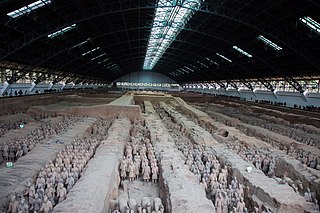 W
WThe Terracotta Army is a collection of terracotta sculptures depicting the armies of Qin Shi Huang, the first Emperor of China. It is a form of funerary art buried with the emperor in 210–209 BCE with the purpose of protecting the emperor in his afterlife.
 W
WA tomb effigy, usually a recumbent effigy or, in French, gisant, is a sculpted figure on a tomb monument depicting in effigy the deceased. These compositions were developed in Western Europe in the Middle Ages, and continued in use through the Renaissance and early modern period; they are still sometimes used. They typically represent the deceased in a state of "eternal repose", lying with hands folded in prayer and awaiting resurrection. A husband and wife may be depicted lying side by side. An important official or leader may be shown holding his attributes of office or dressed in the formal attire of his official status or social class.
 W
WThe Tomb of Antipope John XXIII is the marble-and-bronze tomb monument of Antipope John XXIII, created by Donatello and Michelozzo for the Florence Baptistry adjacent to the Duomo. It was commissioned by the executors of Cossa's will after his death on December 22, 1419 and completed during the 1420s, establishing it as one of the early landmarks of Renaissance Florence. According to Ferdinand Gregorovius, the tomb is "at once the sepulchre of the Great Schism in the church and the last papal tomb which is outside Rome itself".
 W
WThe tomb of Francis II, Duke of Brittany is a monument located in Nantes, in the Cathedral of St. Peter. The project was commissioned by Anne of Brittany, Queen of France, who was the daughter of Francis and his second wife Margaret of Foix, who is also depicted beside Francis. The tomb was originally located in the chapel of the Carmelites in Nantes. Francis II had wished that his body rest there, to join the remains of his first wife Margaret of Brittany. The tomb eventually received the body of Francis and both his wives, though only his second wife is depicted.
 W
WThe Tomb of Louis XII and Anne of Brittany is a large and complex silver-gilt and marble sculptured funerary monument. Its design and build are usually attributed to the Juste brothers although the work of several other hands can be distinguished. Designed for and installed at the Saint-Denis Basilica, France, it was commissioned in 1515 in memory of Louis XII and his queen Anne of Brittany, probably by Louis' successor Francis I, and after years of design and intensive building was unveiled in 1531.
 W
WThe Tomb of Philip the Bold is a funerary monument commissioned in 1378 by the Duke of Burgundy Philip the Bold for his burial at the Chartreuse de Champmol, the Carthusian monastery he built on the outskirts of Dijon, in today's France. It was designed and built by Jean de Marville, head of the duke's sculptural studio, who designed and oversaw the building of the charterhouse. Marville began work on the tomb in 1384, but progressed slowly until his death in 1389. That year Claus Sluter took over design of Champmol, including the tomb. Philip died in 1402 with his funerary monument still very much incomplete. After Sluter's death c. 1405/06, his nephew Claus de Werve completed the project in 1410.
 W
WThe Tomb of Philippe Pot is a 15th-century funerary monument commissioned by Philippe Pot, royal steward of Burgundy under Louis XI, between c. 1477 and 1480 for his burial at the chapel of Saint-Jean-Baptiste in Cîteaux Abbey, south of Dijon, France. No definitive attributions have been made as to the artists and craftsmen who created the work, but Antoine Le Moiturier is often suggested to have produced the eight near life-sized mourners.
 W
WThe ushabti was a funerary figurine used in ancient Egyptian funerary practices. The Egyptological term is derived from 𓅱𓈙𓃀𓏏𓏭𓀾 wšbtj, which replaced earlier 𓆷𓍯𓃀𓏏𓏭𓀾 šwbtj, perhaps the nisba of 𓈙𓍯𓃀𓆭 šwꜣb "Persea tree".
 W
WWooden tomb models were deposited as grave goods in the tombs and burial shafts in Middle Kingdom of Egypt. They included a wide variety of wooden figurines and scenes, such as boats, granaries, baking and brewing scenes and butchery scenes.